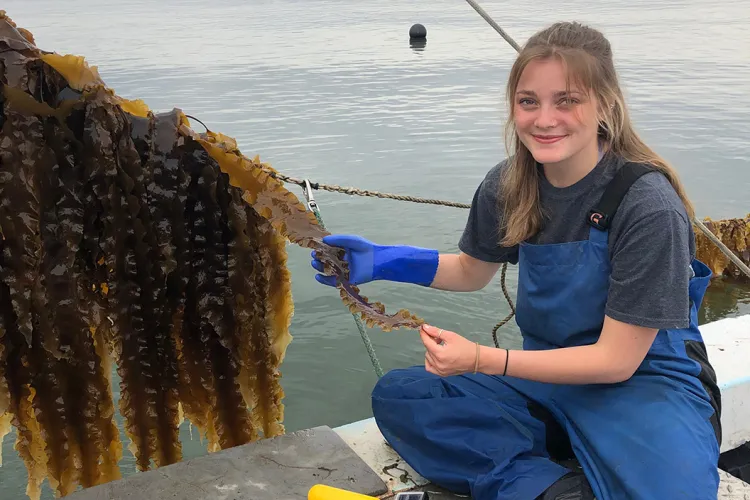Meagan Currie ’20 Spends Summer Working on Kelp Biofuel Project

Meagan Currie ’20 has spent her summer at the Woods Hole Oceanographic Institution, identifying kelp strains with an interest in the biofuel potential of the plant.
Woods Hole Oceanographic Institution — “King Kelp”
“Thirteen point two.” One scientist calls out the measurement; another jots it down in her data sheet. It’s hot and stuffy in the lab, and the pungent smell of seaweed is inescapable as the team sits for hours at a black table measuring blades of sugar kelp—brownish seaweeds that look like oversized slabs of bacon.
“Nine point four." Another data entry.
Using a mix of rulers, calipers, and measuring tapes, a dozen scientists — a seaweed science task force including biology and political science major Meagan Currie ’20 — are sizing up thousands of individual kelp blades recently harvested from a research farm in New England in order to find the best specimens for selective breeding. It’s a long, exacting process, but for the Woods Hole Oceanographic Institution (WHOI), it’s a key step toward turning the ocean crop into a global energy source for the future.
“As opposed to corn, soy, or other land crops, kelp is as low-impact as any natural biofuel source can be,” says Currie, who grew up around marine industries in her hometown of Cumberland Center, Maine. “It requires no land to grow, requires no freshwater or excess nutrients, and can actually remediate the waste runoff from fish or shellfish farms, which can be harmful to the surrounding ecosystem. We have never bred kelp the way that we have cultivated land crops, so there remains huge potential for breeding and developing the industry in a sustainable way.”
Currie is no stranger to researching the applications of seaweeds like kelp; prior to attending Swarthmore, she spent part of a gap year at the Scottish Association for Marine Science and had the chance to speak with leading seaweed specialists about cultivation techniques. Currie also studied abroad in Australia last fall and focused her independent research project on the burgeoning Australian seaweed industry.
In addition to her work identifying the best kelp strains for crossbreeding desirable traits, Currie has spent time this summer studying possible improvements in seeding and planting methods.
“I am investigating how far along in development it is best to expose embryonic kelp, or gametophytes, to the lines onto which they will hopefully anchor and grow into mature kelp,” she says. “I’m also looking to see if there is any variation between species regarding this time span to see if some strains mature faster than others. My work will hopefully feed into future research and the next few years of this larger project.”
Swarthmore is investing in its vibrant intellectual culture. Learn how at lifechanging.swarthmore.edu.



